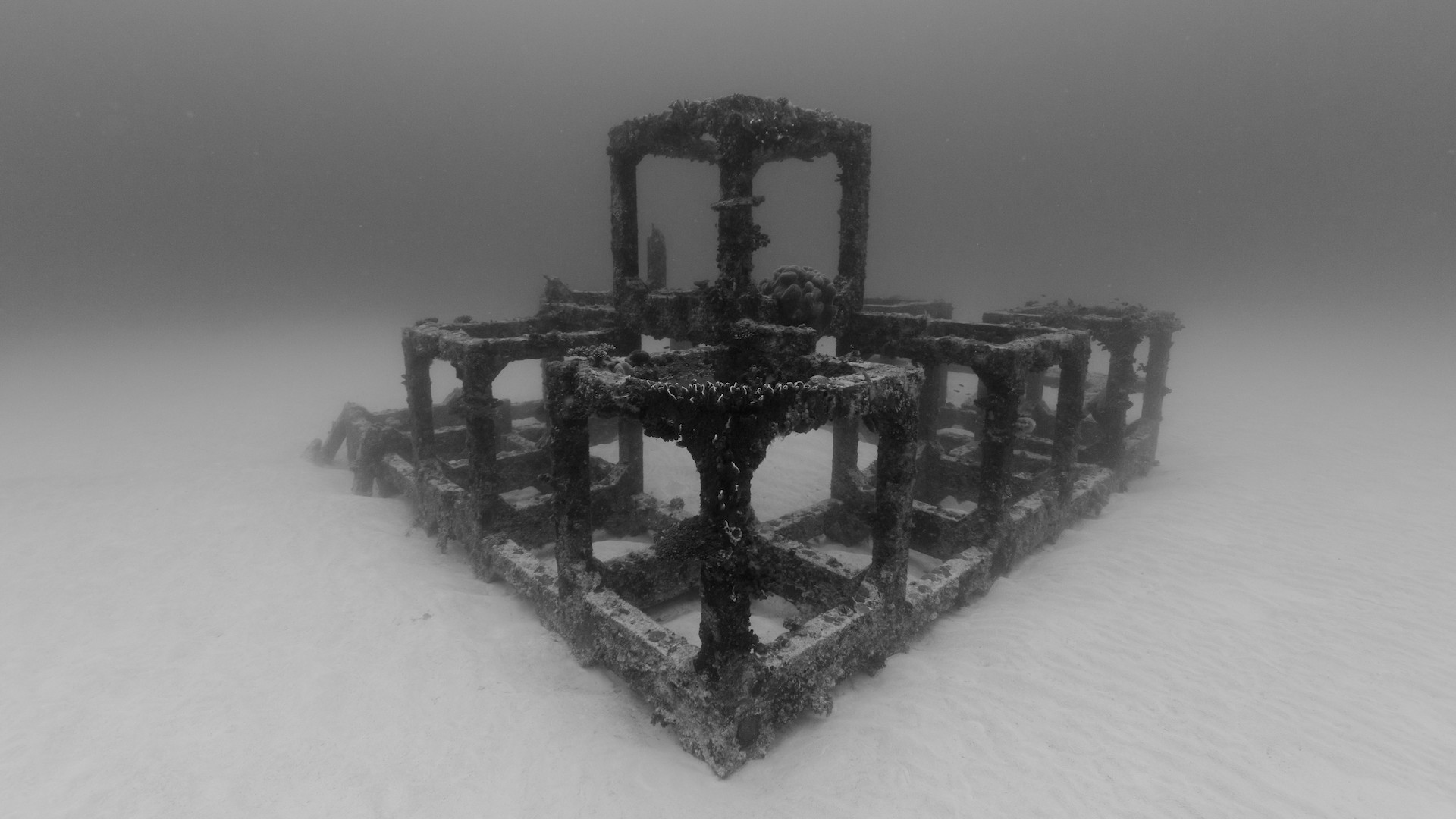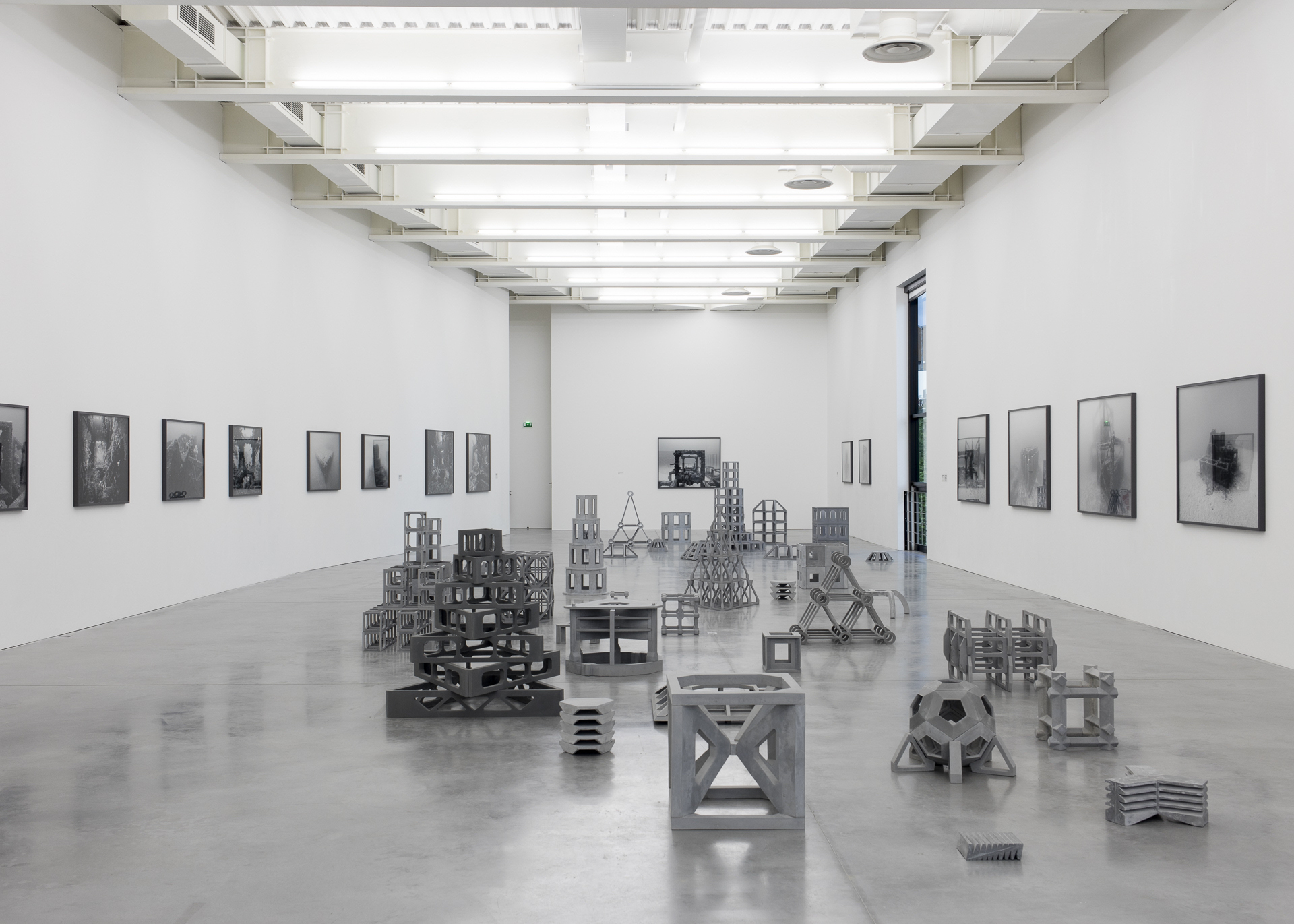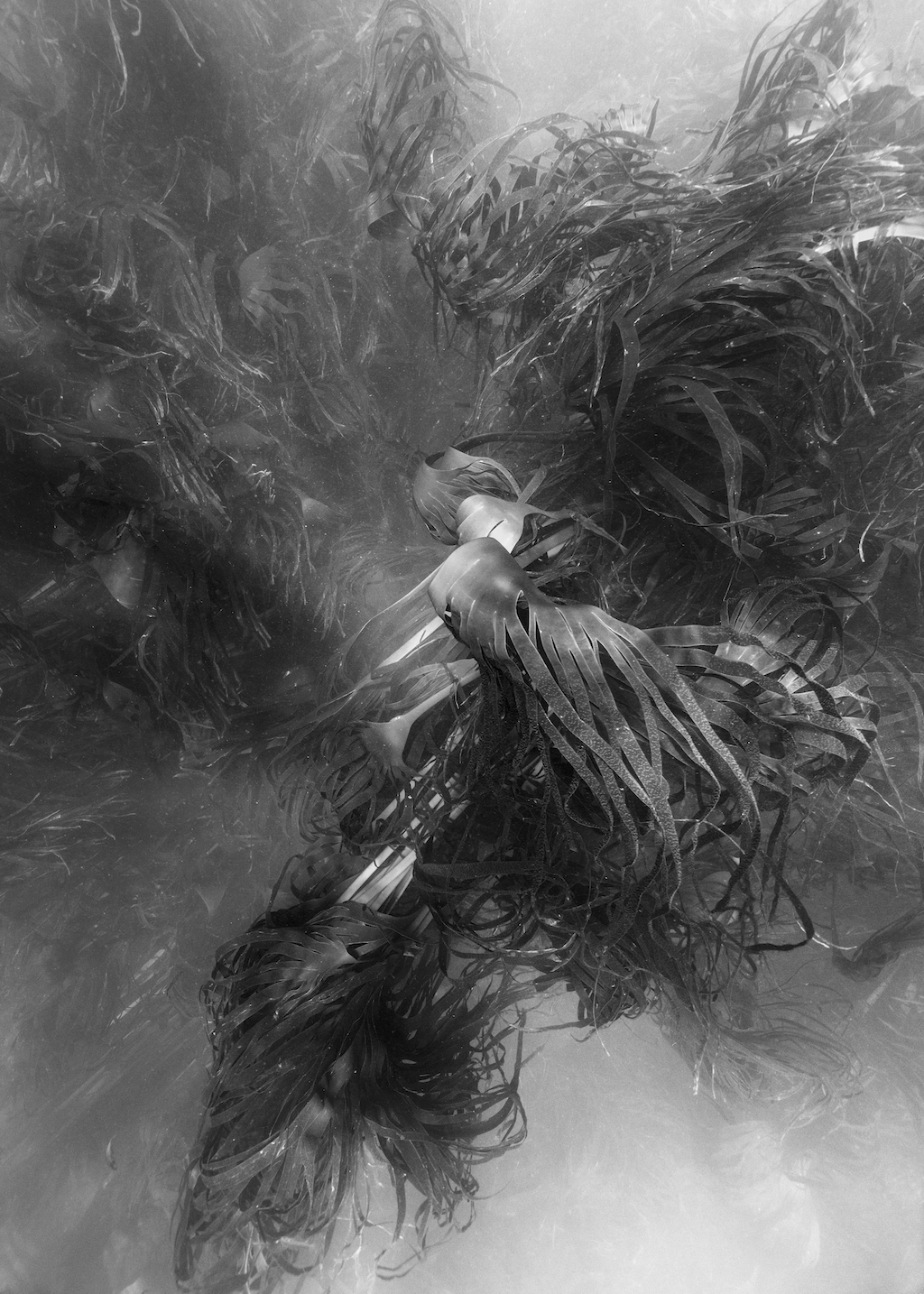Nicolas Floc’h

This autumn, Nicolas Floc’h was invited to make use of all the FRAC Bretagne premises for a solo show mysteriously titled “Glaz”. His work, which has developed around production methods involving autonomous structures generating their own forms, is today finding new developments based on major research carried out since 2010 on manmade reefs. Filled with these fish-rich habitats whose purpose is the survival of the human race, the ocean has a place of paramount importance in Nicolas Floc’h’s way of thinking, unfurling through series of photographs, sculptures, paintings and installations, as well as an acoustic piece and a performance.
Perhaps we could start this interview by mentioning your current show at the FRAC Bretagne?

Nicolas Floc’h, Structures productives, récifs artificiels, sculptures, 2012/2017 ; photographies, 2011-2017. View of the exhibition at the Frac Bretagne, Rennes. Photo : Nicolas Floc’h.
I’ve come up with a project on the scale of the whole building, in which the spectators are faced with an evolution: the exhibition opens with La Tour pélagique (2008), a fishing net taking the form of the Eiffel Tower on a scale of 1:1, an object associated with people’s activity and their daily round, the farming of resources. The higher up you go, the more you enter an underwater realm with a set of dovetailed scales: first of all, pieces relating to the manmade reefs which I’ve been at work on since 2010, then, in the second space, natural habitats, with a landscape dimension, and last of all the final room with a work on the scale of a planetary ecosystem, which man is part of. This latter, which lends its title to the show, is a productive painting, meaning a culture of micro-algae and cyanobacteria, which appear to be green in the photobioreactor I present, but which contain a blue pigment (phycocyanin), applied on the walls of the whole space. This immersive space, which also contains a large neon reproducing the currents of the Gulf Stream, refers us both to the origins of the living world and to the great forces and interactions which govern the ecosystems and permit life: light, water, air, currents, sediments, mineral salts, plankton, oxygen…
It just so happens I wanted to ask you about the world that you introduce in your photographs, sculptures and installations: the bodies (human and animal) seem to have disappeared altogether from these underwater spaces which present an austere world where living things do not emerge very much, apart from by way of phytoplankton.
On the contrary, the underwater environment is much lived in, but a large part of that life cannot necessarily be seen by the naked eye and, in the underwater images, I do my utmost to depict habitats rather than inhabitants. The depth indicated in the title of the images tallies with that of the manmade reef but also that of the shot: the physical involvement, as in many of my works, here appears off-screen!
In my work I’ve always factored in the living element, be it vegetal, animal or human, in particular through works such as Carbone (2016-2017) in the “Glaz” exhibition, and the Structure multifonctions (2000-2007): structures formed by modules enabling visual artists, musicians and dancers to re-invent them and re-interpret them. I’m also thinking of the Ecritures productives (1995-1997), where words produced what they were describing—a trawler fishing writing “fish”, a salt marsh forming the word “salt”, and cultures forming the words “tomatoes”, “lettuces” , “strawberries”, and the like.
The anthropocene notion faces us with space-time scales which force us to question our relation to the world. This is indeed why working on the ocean seems to me to be essential, because what is involved is an interconnected and moving space, in which water is forever interacting with air and the earth. Today, I think it’s important to manage to construct projects which are not necessarily anthropocentric. My research on manmade reefs in fact tries to think of structures which take into account the ecosystems that man is reliant upon, because they are conceived to feed him, but they are not focused on him as far as how they function is concerned.
The images I make of seabeds run counter to the classic underwater iconography which includes a green or blue dominant and multi-coloured fish and corals underscored by the flash. Conversely, I would like people to be able to see my photographs of reefs and landscapes essentially in black and white, as environments focusing on the structures of the habitats but also very undefined, which might equally be under the sea and on other planets.
Undefinedness seems to me to be a major ingredient of your work: you have been interested in camouflage, for example with the Razzle Dazzle wall painting 1944, shown in 2005 at the Confort Moderne arts centre; some of your photographs are totally abstract, like Colonne d’eau, -10m, Ouessant, 2016, which is a black and white view of the inside of the ocean, and the actual title of your exhibition “Glaz”, is a eulogy to undefinedness.
The Breton word glaz, which means a colour somewhere between blue and green, is both the colour of the sea and its variations, and also that of all plants. The sea, a field, the countryside and a tree are glaz, and this is why the term interests me. In our representations, water and plants are very distinct, whereas in reality the vegetal is very present in the ocean: so water containing not much phytoplankton will have a blue dominant, and water with a lot of phytopolankton will be greener. Needless to say, the Breton adjective glaz seems to be extremely local and regional, although it is in fact a more global word. The planet, which is often depicted green and blue, is probably more glaz. But rather than undefinedness, it is the confrontation of certain art categories—such as painting, sculpture, photography and installation—with reality, and an ongoing back-and-forth between these categories and the world which define my work more.
Could you explain what fascinates you so much in the ocean, in its relation to invisibility?
I’ve been diving since I was a kid, and this relation to the surface, to what is woven beneath, has always been important. My attachment to the ocean, with the expanse of sea and sky, as well as a 360o immersion in colour when you’re diving, have prompted my interest in monochrome painting. For many years I’ve been trying to formulate this relation to monochromy, and working on the ocean’s colour has become a logical way in: so I’ve recently produced the acoustic piece La couleur de l’eau (2017), in which the scientist Hubert Loisel raises this issue. I’ve been lucky enough to work with the marine station at Wimereux, not far from Boulogne-sur-Mer, where another scientist, Fabrice Lizon, is studying the cellular composition of phytoplankton. Our exchanges have helped me to understand that this latter produced pigments which could be extracted. It is these pigments that I’ve vaporized on all the walls in the FRAC’s main gallery and I’m going to continue developing this new approach to colour.
I was also wondering about your propensity to show what we don’t see and what we no longer see: in the Peintures recyclées (2000-2004), you had asked some painters to give you a canvas which they didn’t want to exhibit, from which you recycled the paint, be it in tube or pot form, and for the Performance painting #4 (2007) you exhibited carpets on which dancers had already performed, lifting them up and showing their traces, memories of their steps… I was also thinking, in your latest works, about this desire to show what is happening under the water, seeking out reefs and making them visible, giving them back a form, in terms of volume, based on documentary sculptures.

Nicolas Floc’h, La Tour pélagique, 2008. Nylon nets and wires, two Goeschman slide projectors, 6×7 slides. Co-production Biennale de Rennes, Collection Frac Bretagne. Photo : Nicolas Floc’h.
There’s a whole part of my work where I actually try to reveal what’s invisible: for example, Pélagique is a fishing net that I decided to spread out in the central nave at the CAPC in Bordeaux—for the exhibition “Hors-d’oeuvre” in 2004—although it can’t normally be seen. Conversely, there are highly visible things which I choose to move: this is the case with La Tour pélagique, above-mentioned, which once more becomes an invisible object, once it is spread out under the water, and which I exhibit as such, folded in on itself. For the Peintures recyclées, the matter remains but the image has disappeared; what is left is a monochrome paste. For me, the core of the work does not always lie in the visible, and the visual work can at times disappear; in this sense, I would agree with Allan Kaprow who, in his compilation Essays on the Blurring of Art and Life, refers to everyday gestures as performances, but without them being necessarily observed by spectators. What I’m trying to show is a very small part of what can take place in the whole process that’s at work.

Nicolas Floc’h, La Tour pélagique, 2008. Nylon nets and wires, two Goeschman slide projectors, 6×7 slides. Co-production Biennale de Rennes, Collection Frac Bretagne. Photo : Nicolas Floc’h.
I’m going to follow up this idea of process and ask you about the production of your works: at the FRAC as in all the venues where you show your work, there are long lists of acknowledgements on the walls! Your work calls upon a lot of partners: interlocutors, scientists, students, institutions, research groups, sponsors and patrons, and so on.
If we take the example of the room titled “Les villes immergées” [Submerged cities] at the FRAC Bretagne, this work was developed over a seven-year period with support ranging from research assistance from the CNAP [National Centre for Plastic Arts] and meetings with scientists to working with different places (art centre, museum, FRAC…) in the production of the various stages and works in the project. Producing just one image sometimes requires a lot of authorizations, depends on the weather, and involves a great deal of organization. To produce what is on view in this room calls for about ten partners and many years of work. It seems to me important to mention within one structure all the other structures that have contributed to the existence of what is on view.
Furthermore, I’m trying to set up projects which have a collective dimension, like for example Surfer un arbre (from 2016 on), for which I proposed that a group of artists/surfers work on the trunk of a red cedar which made it possible to make 42 traditional Hawaiian surfboards and a bench. Each artist taking part in the project was able to work on the preparation of his surfboard, which he would then keep for surfing sessions, and also as a starting point for artistic propositions to come; so what I’m setting up is at once a film and a workshop, but also a working community and shared times around the act of surfing and that of exhibiting.
I’m also involved in several projects associated with the nouveaux commanditaires [new patrons] programme, the Daniel and Nina Carasso foundation, and the Tara expeditions foundation, a whole network of research and sharing rooted in reality.

Nicolas Floc’h, Paysages Productifs, Macro-algues, –8 m, Ouessant, 2016. Pigment print on Fine Art matte paper, 150 × 210 cm, production centre d’art la Criée / EESAB, Rennes. Photo : Nicolas Floc’h.
I know that you’ve been teaching at the EESAB (in Rennes) for six years. How do you see this experience which, it so happens, perforce involves an action that is both individual and collective?
I arrived in Rennes just when the EESAB was being created (a grouping of four schools in Brittany—Rennes, Lorient, Quimper and Brest—in a multi-site school). Outside the region there was no site, no shared building. I became associated with two other artists/teachers, Jocelyn Cottencin and Erwan Mével, and we set up a moveable, shared site on an old trawler which could accommodate 12 students: the B.O.A.T. project, which has already taken in more than 150 students from the four sites in two years, offered artist’s residencies, and scoured the shores of Brittany and Normandy, and we’re now envisaging a B.O.A.T. semester for a small group of students who will work on a common project. With the EESAB, we’ve also just launched a research unit, “Demain l’océan” [Tomorrow’s Ocean]. Being an artist these days means acting in a world in a state of great transition, and challenging contexts that are being forever renewed. The ocean is probably the territory which allows us to approach what is coming, it lies at the heart of the great challenges awaiting us. Tomorrow, inhabiting, feeding ourselves and having exchanges will all be determined by the way it evolves.
(Image on top: Nicolas Floc’h, Structures productives, récif artificiels, -18 m, Kikaijima, Japon, 2017. Pigment print on matte Fine Art paper, 110 x 137,5 cm. Leg Japon, Expédition Tara Pacific. Photo : Nicolas Floc’h.)
Related articles
Céline Poulin
by Andréanne Béguin
Émilie Brout & Maxime Marion
by Ingrid Luquet-Gad
Interview with Warren Neidich
by Yves Citton



